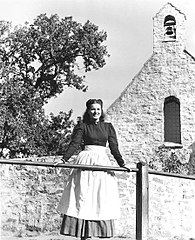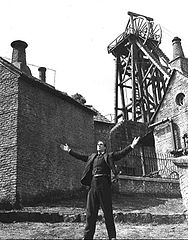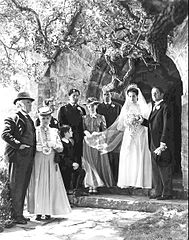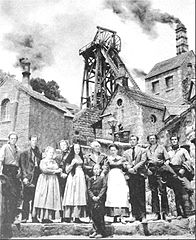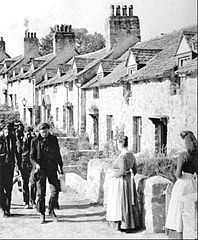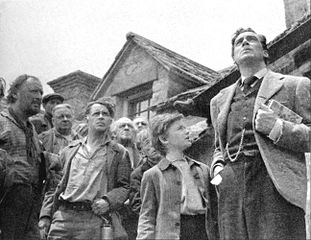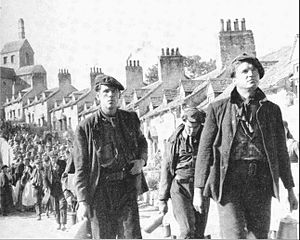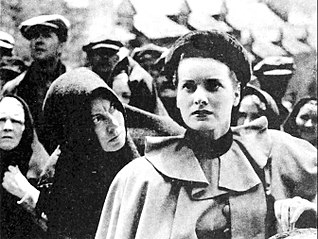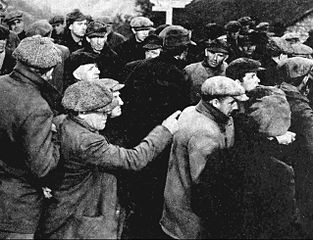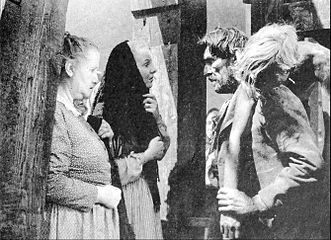fiction.wikisort.org - Movie
How Green Was My Valley is a 1941 American drama film set in Wales, directed by John Ford. The film, based on the best-selling 1939 novel of the same name by Richard Llewellyn, was produced by Darryl F. Zanuck and scripted by Philip Dunne. It stars Walter Pidgeon, Maureen O'Hara, Anna Lee, Donald Crisp, and a very young Roddy McDowall.
| How Green Was My Valley | |
|---|---|
 Theatrical release poster | |
| Directed by | John Ford |
| Screenplay by | Philip Dunne |
| Based on | How Green Was My Valley 1939 novel by Richard Llewellyn |
| Produced by | Darryl F. Zanuck |
| Starring | |
| Narrated by | Irving Pichel |
| Cinematography | Arthur C. Miller |
| Edited by | James B. Clark |
| Music by | Alfred Newman |
| Distributed by | Twentieth Century-Fox Film Corporation |
Release date |
|
Running time | 118 minutes |
| Country | United States |
| Languages | English Welsh |
| Budget | $800,000[1] |
| Box office | $2.4 million[2] |
It tells the story of the Morgans, a hard-working Welsh mining family, from the point of view of the youngest child Huw, who lives with his affectionate and kind parents as well as his sister and five brothers, in the South Wales Valleys during the late Victorian era. The story chronicles life in the South Wales coalfields, the loss of that way of life and its effects on the family. The fictional village in the film is based on Gilfach Goch,[3] where Llewellyn spent many summers visiting his grandfather, and it served as the inspiration for the novel.[3]
It was nominated for ten Academy Awards, winning five,[4] famously beating Citizen Kane, Sergeant York and The Maltese Falcon for Best Picture, while Ford won for Best Director, Donald Crisp for Best Supporting Actor, Arthur Miller for Best Cinematography, and Richard Day, Nathan H. Juran and Thomas Little for Best Black-and-White Art Direction-Interior Decoration. In 1990, the film was selected for preservation in the United States National Film Registry of the Library of Congress as being "culturally, historically, or aesthetically significant".[5][6] The Academy Film Archive preserved How Green Was My Valley in 1998.[7]
Plot

The film begins with a monologue by an older Huw Morgan (voiced by Irving Pichel):[lower-alpha 1] "I am packing my belongings in the shawl my mother used to wear when she went to the market. And I'm going from my valley. And this time, I shall never return." The valley and its villages are now blackened by the dust of the coal mines that surround the area.
A young Huw (Roddy McDowall), the youngest child of Gwilym Morgan (Donald Crisp), walks home with his father to meet his mother, Beth (Sara Allgood). His older brothers, Ianto (John Loder), Ivor (Patric Knowles), Davy (Richard Fraser), Gwilym Jr. (Evan S. Evans), and Owen (James Monks) all work in the coal mines with their father, while sister Angharad (Maureen O'Hara) keeps house with their mother. Huw's childhood is idyllic; the town, not yet overrun with mining spoil, is beautiful, the household is warm and loving, and the miners sing as they walk home (in this case "Bread of Heaven" in Welsh). The wages are collected, the men wash then eat together. Afterwards the spending money is given out. Huw is smitten on meeting Bronwyn (Anna Lee), a girl engaged to be married to his eldest brother, Ivor (Patric Knowles). At the boisterous wedding party Angharad meets the new preacher, Mr. Gruffydd (Walter Pidgeon), and there is an obvious mutual attraction.
Trouble begins when the mine owner decreases wages, and the miners strike in protest. Gwilym's attempt to mediate by not endorsing a strike estranges him from the other miners as well as his older sons, who quit the house. Beth interrupts a late night meeting of the strikers, threatening to kill anyone who harms her husband. She and Huw head across the fields in a snowstorm in the dark to return home. Later on their way home the strikers hear Huw calling for help. They rescue Beth and Huw from the river. Beth has temporarily lost the use of her legs and the doctor fears that Huw, who has also lost the use of his legs, will never walk again. He eventually recovers with the help of Mr. Gruffydd, which further endears the latter to Angharad.
The strike is eventually settled, and Gwilym and his sons reconcile, yet many miners have lost their jobs. The exceptionally beautiful Angharad is courted by the mine owner's son, Iestyn Evans (Marten Lamont), though she loves Mr. Gruffydd. Mr. Gruffydd loves her too, to the malicious delight of the gossipy townswomen, but cannot bear to subject her to the hard, spartan life of an impoverished churchman. Angharad submits to a loveless marriage to Evans, and they relocate out of the country.
Huw begins school at a nearby village. Abused by other boys, he is taught to fight by boxer Dai Bando (Rhys Williams) and his crony, Cyfartha (Barry Fitzgerald). After a beating by the cruel teacher Mr. Jonas (Morton Lowry), Dai Bando avenges Huw with an impromptu boxing display on Mr. Jonas to the delight of his pupils.
Bronwyn learns Ivor has been killed in a mine accident. The shock causes her to go into labor and she gives birth to a son. Later, two of Morgan's sons are dismissed in favor of less experienced, cheaper laborers. With no job prospects, they leave to seek their fortunes abroad. Huw is awarded a scholarship to university, but to his father's dismay he refuses it to work in the mines. He relocates with Bronwyn, to help provide for her and her child.
When Angharad returns without her husband, vicious gossip of an impending divorce spreads through the town. It is eventually announced there will be a meeting of the Deacons - the governing council of the local Calvinistic Methodist chapel - to discuss, denounce and excommunicate Angharad. This prospect enrages Mr. Gryffudd, for he knows she has done nothing other than return home from Cape Town without her husband. After condemning the Deacon's small-mindedness, he storms out before the meeting intent on leaving the town.
But that evening, the alarm whistle sounds, signalling another mine disaster. Several men are injured, and Gwilym and others are trapped in a cave-in. Mr Gryffudd catches sight of Angharad, who has rushed to the mine for word of her father; and we know from his expression that he will never leave now. As she looks pleadingly at him, he calls, "Who is for Gwilym Morgan and the others?"
Young Huw, Mr. Gruffydd, and Dai Bando then descend with other volunteers to rescue the remaining miners. Gwilym and his son are briefly re-united before he succumbs to his injuries.
Above, in the cold of light dawn, the women of the family - Angharad, Bronwyn and Beth Morgan - have stood vigil all night; when Beth says, just after Gwilym's death, "He came just now. Ivor was with him. He told me of the glories he had seen!" Then the sound of the pulley announces the lift is returning from the depths of the mine. Huw is cradling his father's body, his coal-blackened face devoid of youthful innocence.
Narration by an older Huw recalls, "Men like my father cannot die. They are with me still, real in memory as they were in flesh, loving and beloved forever. How green was my valley then." The movie ends with a montage of family vignettes showing Huw with his father and mother, his brothers and sister.
Cast
|
|
Production
The script was written by Philip Dunne. He later recalled reading the original novel "in horror, turgid stuff, long speeches about Welsh coal miners on strike."[9]
William Wyler, the original director, saw the screen test of McDowall and chose him for the part. Wyler was replaced by John Ford. Fox wanted to shoot the movie in Wales in Technicolor, but it was impossible to do so during World War II. Instead, Ford had the studio build an 80-acre authentic replica of a Welsh mining town at Brent's Crags[8] (subsequently Crags Country Club) in the Santa Monica Mountains near Malibu, California.[10]
Reception
On Rotten Tomatoes, How Green Was My Valley held, as of July 2022[update], an approval rating of 93% based on 84 reviews, with an average rating of 7.9/10. The site's critics consensus reads: "Though it perhaps strays into overly maudlin territory, this working-class drama is saved by a solid cast and director John Ford's unmistakable style."[11] Tim Dirks of Filmsite.org lauded the film as "one of John Ford's masterpieces of sentimental human drama."[12]
While the opinion among the Academy Awards committee that it was 1941's Best Picture has been disputed by some later critics,[13][14] How Green Was My Valley continues to be well received in its own right and, in 1990, was added to the American National Film Registry. Academy Award-winning actor and director Clint Eastwood named it as one of his favorite movies.[15]
Accolades

| Award | Category | Nominee | Result |
|---|---|---|---|
| Academy Awards[16] | Outstanding Motion Picture | Darryl F. Zanuck | Won |
| Best Director | John Ford | Won | |
| Best Supporting Actor | Donald Crisp | Won | |
| Best Supporting Actress | Sara Allgood | Nominated | |
| Best Screenplay | Philip Dunne | Nominated | |
| Best Art Direction-Interior Decoration – Black-and-White | Richard Day, Nathan H. Juran and Thomas Little | Won | |
| Best Cinematography – Black-and-White | Arthur Miller | Won | |
| Best Film Editing | James B. Clark | Nominated | |
| Best Scoring of a Dramatic Picture | Alfred Newman | Nominated | |
| Best Sound Recording | Edmund H. Hansen | Nominated | |
| Argentine Film Critics Association Awards[17] | Best Foreign Film | John Ford | Won |
| National Film Preservation Board | National Film Registry | Inducted | |
| New York Film Critics Circle Awards[18] | Best Director | John Ford | Won |
American Film Institute Lists
- AFI's 100 Years...100 Movies - Nominated[19]
- AFI's 100 Years...100 Movie Quotes:
- "Men like my father cannot die. They are with me still -- real in memory as they were in flesh, loving and beloved forever. How green was my valley then." - Nominated[20]
- AFI's 100 Years of Film Scores - Nominated[21]
- AFI's 100 Years...100 Movies (10th Anniversary Edition) - Nominated[22]
Adaptations
How Green Was My Valley was adapted as a half-hour radio play on the March 22, 1942 broadcast of The Screen Guild Theater, with Sara Allgood, Donald Crisp, Roddy McDowall, Maureen O'Hara and Walter Pidgeon.[23][24]
It was also adapted for three one-hour broadcasts of the Lux Radio Theatre: on September 21, 1942, with Allgood, Crisp, O'Hara, McDowall and Pidgeon;[25] on March 31, 1947, with Crisp and David Niven;[26] and on September 28, 1954, with Crisp and Donna Reed.[27]
See also
- How Green Was My Valley (novel)
- The Proud Valley
- The Stars Look Down
- 1926 United Kingdom general strike
- English-language accents in film – Welsh
References
- Footnotes
- Some sources credit the narration to Rhys Williams[8]
- Citations
- Solomon, Aubrey (1989). Twentieth Century Fox: A Corporate and Financial History. Lanham, Maryland: Scarecrow Press, p. 241, ISBN 978-0-8108-4244-1.
- "All-time Film Rental Champs". Variety. October 15, 1990.
- (February 7, 2009)"How Green Was My Valley", BBC Radio Wales. Retrieved August 20, 2019.
- "How Green Was My Valley". Movies & TV Dept. The New York Times. 2009. Archived from the original on 2009-03-02. Retrieved 2008-12-13.
- Gamarekian, Barbara; Times, Special To the New York (1990-10-19). "Library of Congress Adds 25 Titles to National Film Registry (Published 1990)". The New York Times. ISSN 0362-4331. Retrieved 2020-10-30.
- "Complete National Film Registry Listing". Library of Congress. Retrieved 2020-10-30.
- "Preserved Projects". Academy Film Archive. Retrieved August 20, 2019.
- Maltin, Leonard. "How Green Was My Valley (1941) - Notes - TCM.com". Turner Classic Movies. TCM Interactive Group. Retrieved August 20, 2019.
- Philip Dunne looks back at movies' golden age: [SA2 Edition]Jim Bawden Toronto Star 27 Jan 1990: G8.
- Rasmussen, Cecilia (January 21, 2007). "Hollywood and the History of Malibu Creek State Park". Los Angeles Times. Retrieved August 20, 2019.
- "How Green Was My Valley (1941)". Rotten Tomatoes. Fandango Media. Retrieved July 27, 2022.
- Dirks, Tim. "How Green Was My Valley (1941)". AMC. Retrieved August 20, 2019.
- Susman, Gary (February 19, 2013). "Oscar Robbery: 10 Controversial Best-Picture Races – 1942: 'Citizen Kane' vs. 'How Green Was My Valley'". TIME.
- Hathaway, Hashim (January 25, 2017). "25 times the Oscars got it wrong". Yardbarker. Retrieved April 20, 2019.
- "Clint Eastwood's Favorite 'Golden Age' Films". Parade. April 29, 2012.
- "The 14th Academy Awards (1942) Nominees and Winners". Retrieved August 20, 2019.
- "Historia de la Asociación de Cronistas Cinematográficos de la República Argentina". Puestaenescena.com.ar. Retrieved August 20, 2019.
- "How Green Was My Valley (1941)". AFI Catalog of Feature Films. American Film Institute. 2019. Retrieved January 4, 2021.
- "AFI's 100 Years...100 Movies Nominees" (PDF). afi.com. Retrieved August 20, 2019.
- "AFI's 100 Years...100 Movie Quotes Nominees" (PDF). afi.com. Retrieved August 20, 2019.
- "AFI's 100 Years of Film Scores Nominees" (PDF). afi.com. Retrieved August 20, 2019.
- "AFI's 100 Years...100 Movies (10th Anniversary Edition) Ballot" (PDF). afi.com. Retrieved August 20, 2019.
- "Radio Day by Day". The Reading Eagle. 1942-03-22. p. 18. Retrieved 2021-04-29.
- Haendiges, Jerry (2021-02-24). "Series: "THE SCREEN GUILD THEATER"". (via the website: Jerry Haendiges Vintage Radio Logs). Retrieved 2021-04-29.
- "WFMJ Will Broadcast "Spotlight Bands" Show". Youngstown Vindicator (Ohio). 1942-09-21. p. 7. Retrieved 2020-12-12.
- Si Steinhauser (1947-03-31). "Radio To Launch National Fight On Cancer". The Pittsburgh Press. p. 25. Retrieved 2020-12-12.
- "Tuesday Radio Programs". Toledo Blade (Ohio). 1954-09-28. p. 4 (Peach Section). Retrieved 2020-12-12.
External links
- How Green Was My Valley at IMDb
- How Green Was My Valley at the TCM Movie Database
- How Green Was My Valley at AllMovie
- How Green Was My Valley at the American Film Institute Catalog
- How Green Was My Valley at Rotten Tomatoes
- How Green Was My Valley at Reel Classics
- How Green Was My Valley at Film Site web site; contains plot detail.
- Eagan, Daniel (2009). "How Green Was My Valley". America's Film Legacy: The Authoritative Guide to the Landmark Movies in the National Film Registry. New York: Continuum. pp. 339–341. ISBN 978-1-4411-1647-5. OCLC 676697377.
На других языках
[de] Schlagende Wetter (1941)
Schlagende Wetter (deutscher Alternativtitel: Schwarze Diamanten, So grün war mein Tal oder auch Starke Herzen) ist ein US-amerikanisches Filmdrama unter der Regie von John Ford aus dem Jahr 1941 nach dem Roman So grün war mein Tal (How Green Was My Valley, 1939) von Richard Llewellyn. Das Werk wurde für insgesamt zehn Oscars nominiert, konnte fünf Trophäen gewinnen und behauptete sich dabei in der Kategorie Bester Film gegen Die Spur des Falken und Citizen Kane. 1990 wurde der Film von der Library of Congress als besonders erhaltenswert angesehen und ins Verzeichnis der National Film Registry aufgenommen.- [en] How Green Was My Valley (film)
[ru] Как зелена была моя долина
«Как зелена была моя долина» (англ. How Green Was My Valley) — американская драма, снятая в 1941 году режиссёром Джоном Фордом. Сюжет ленты представляет собой сценарную обработку Филиппом Данном известного одноимённого романа Ричарда Луэллина и повествует о жизни семьи Морган в угольном бассейне Южного Уэльса в начале XX века. Фильм был выдвинут на премию «Оскар» в 10 номинациях и стал первым в 5 из них[1].Другой контент может иметь иную лицензию. Перед использованием материалов сайта WikiSort.org внимательно изучите правила лицензирования конкретных элементов наполнения сайта.
WikiSort.org - проект по пересортировке и дополнению контента Википедии
